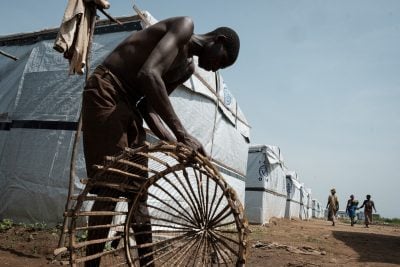With its diverse landscapes and a soil and climate capable of delivering rich harvests, Uganda holds enormous agricultural potential. But for Odrek Rwabwogo, whose brief as special advisor to President Yoweri Museveni includes driving up the value of exports, the country is still punching well below its weight.
Appointed as special advisor in 2021, Rwabwogo is also chair of the Presidential Advisory Committee on Exports and Industrial Development (PACEID), a government institution commissioned in March 2022 with one overarching goal: “addressing and overcoming the strategic and operational bottlenecks that impede Uganda from fully harnessing its industrial and export potential”.
The medium-term goal of Rwabwogo and his team is to lift the value of Uganda’s exports from just under $5bn to $12bn a year by 2028 – and they are upsetting all sorts of apple carts to hit their target.
The need to restore growth
The disruptions of Covid-19 reduced GDP growth from over 6% in 2019 to 3% in 2021. “We wanted to restore that growth, restore the jobs lost,” says Rwabwogo.
The most direct route out of the impasse was identified as export revenue expansion. The process involved in achieving this would, it was judged, automatically raise efficiency and output levels at every stage. Benefits would spill out of the export sector and raise the productivity bar across the economy.
PACEID put 13 of the country’s main products – coffee, sugar, grains, fruit and vegetables, poultry, tourism, beef, dairy, cement, steel, fish, flowers and plant materials and banana flour – under the microscope to see where the bottlenecks were and how to remove them.
“We went through each of those products in a very systematic, intentional way and looked at the gaps that we would need to fill,” Rwabwogo recalls.
The exercise was a forensic analysis of approaches, performance and outcomes of the export sector. The strategy was just like one that a major private sector company determined to break out of its legacy shackles and grow its revenue and profit margins would apply to its operations.
When the dust had settled, it was clear that going forward would entail considerable change – abandoning some traditional systems and procedures and venturing into hitherto unknown territory.
In other words, Rwabwogo says, the former approach to exports, which was in the main haphazard and left to market vagaries, would be abandoned and a streamlined, results-oriented system based on solid market information would be put into place. The strategy is to expand trade in traditional markets, penetrate new markets and add value across the board.
Pillars of the strategy
“There are four pillars to this approach,” Rwabwogo says. “They can be summarised as: compliance and conformity; a new approach to export markets; upgrading export infrastructure and deploying export financing.” Rwabwogo says that, for example, Uganda will stop “blind trade”, by which he means simply exporting to markets without a proper understanding of the market.
Instead, “we want to get into markets after doing some dipstick surveys on tastes and preferences of those markets, what types of products are most suited to them and their consumer behaviour, and then make sure that companies that make those products are linked to buyers.”
As a foundation of the marketing strategy, he sets a lot of store on personal meetings, attending trade fairs and opening trade offices in important destinations. He knows the value of being visible and present, in whatever form, on the global trading floors.
He is keen to set up trade centres where buyers can see and handle products such as the country’s excellent Arabica coffee and the outstanding quality of its fruits and vegetables (see African Business, April 2023). Uganda has trade representatives in the US, the UK, the Balkan region, Democratic Republic of Congo (DRC) and South Africa – five of its most important markets.
On the supply side, PACEID has stiffened its domestic phytosanitary standards to comply with the often-stringent requirements of its high-value markets. It is working on refrigeration modules for its perishables and expanding the capacity of its airports and storage areas.
Adding value
While working to raise the awareness of its products in both traditional as well as new markets and increase the volume of its exports, Rwabwogo is also focusing on value addition.
Exports to the 21 members of the Common Market for Eastern and Southern Africa (COMESA) are worth almost $2bn, with South Sudan, DRC and Kenya accounting for over half of this. With the benefits of the AfCFTA now beginning to emerge, both the volume as well as value of this trade is likely to increase. Given the increasing restrictions on air freight – a major worry for a landlocked country – Uganda’s road-based intra-African trade could become a mainstay in the future.
But the best prices, he says, come from the developed markets. The Middle East, for example, can be a very lucrative destination for Uganda’s beef and dairy products. However, penetrating and expanding volumes in these markets requires smart marketing and ensuring top-quality products.
For example, Uganda exported nearly $860m worth of coffee last year. The bulk of it was the Robusta variety which does not fetch the highest prices. But the country produces the high-value Arabica variety on its volcanic mountain slopes.
“We are producing some of the best Arabica in the world and with just a little value addition to transit to premium brands, the same volume of coffee could fetch circa $3bn and open new markets in China, India and elsewhere,” he says.
Signs are good
With its new knowledge-based and efficiency-driven approach to production, marketing and exports, Uganda is on its way to hitting its ambitious export revenue target by 2028. The implications are profound. Uganda’s economy is still largely based on agriculture, although it does have a budding industrial and oil sector and tourism is beginning to pick up after the lockdown. A doubling of export revenue will lift all boats involved in agriculture and support services, accelerate the pace of industrialisation and provide the jobs that its growing population needs.
The signs are good – World Bank figures show that the growth rate recovered to 4.7% in 2022 and is expected to reach 5.3% this year, while the government forecasts 6.5% in 2024. But for Rwabwogo, this means it’s time to shift gears and put the foot harder to the floor.
Want to continue reading? Subscribe today.
You've read all your free articles for this month! Subscribe now to enjoy full access to our content.
Digital Monthly
£8.00 / month
Receive full unlimited access to our articles, opinions, podcasts and more.
Digital Yearly
£70.00 / year
Our best value offer - save £26 and gain access to all of our digital content for an entire year!

 Sign in with Google
Sign in with Google 



